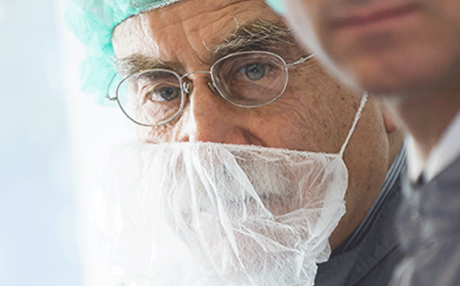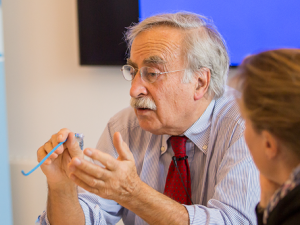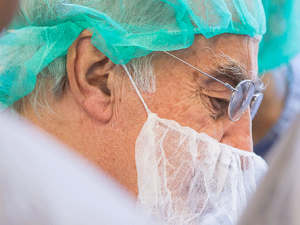 Professor Giulio Frova offers insight into the world of anesthesiology, how he came up with the idea for the Frova Intubating Introducer, and how to handle difficult intubations.
Professor Giulio Frova offers insight into the world of anesthesiology, how he came up with the idea for the Frova Intubating Introducer, and how to handle difficult intubations.
What inspired you to pursue a career in anesthesiology?
It was a fortuitous circumstance. I was on summer holiday. My main interest was to become a psychiatrist, but that changed when I met my girlfriend’s sister and her husband. They were both anesthetists and enthusiastic about this branch of medicine, and they convinced me to enter the field. In the 1960s there was a shortage of anesthetists in Italian hospitals.
What are the most important tools that you and your team can equip yourselves with to help you achieve successful outcomes?
The tools are listed in most of the international guidelines on difficult airway management. In Italy, the suggested tools for airway emergency are facial and laryngeal masks, tracheal tubes, and direct laryngoscope with auxiliary devices like the tracheal introducer. Video laryngoscopes and flexible endoscopes are suggested to have on hand as well. In an emergency the concept is: the simpler it is, the better it works.
 The American Society of Anesthesiologists (ASA) published the first difficult airway algorithm in 2003. Were you thinking of the ASA algorithm, or any other algorithm, when you were developing the Frova Intubating Introducer?
The American Society of Anesthesiologists (ASA) published the first difficult airway algorithm in 2003. Were you thinking of the ASA algorithm, or any other algorithm, when you were developing the Frova Intubating Introducer?
No algorithm influenced me, but I used my 30 years of personal experience practicing in hospitals for inspiration. I saw an open space in the market for producing an introducer with better features than existing devices.
I do strongly support the idea of an algorithm as a pre-established safety pathway to follow when experiencing critical situations like a difficult airway.
What are the key principles the anesthesiologist lives by when intubating?
He or she must know an algorithm, have a plan A, and have a rescue plan. It’s also fundamental to minimize trauma and avoid multiple intubation attempts that could harm the patient. Also, remember that intubation is a process where the true target is always to guarantee oxygenation. Another key principle is to have acquired expertise in the use of basic devices.
 Tell us about an experience where a patient had a difficult intubation, and describe how you handled it.
Tell us about an experience where a patient had a difficult intubation, and describe how you handled it.
In an operating theater, a female patient was very difficult to intubate, and my assistant, in charge of the anesthetic, performed many attempts before intubating her without using an introducer. At the end of intervention, two hours later, my assistant removed the tube without any protection, and the patient immediately became asphyxic* [asphyxia is a condition caused by a lack of oxygen and can result in suffocation]. I was called, and in less than two minutes I performed a cricothyrotomy with simple devices I found in the OR (a scalpel, forceps, stylet, and a small-sized tracheal tube). The patient recovered, and I sat taking a deep breath.
How do you feel during emergent difficult intubation? What goes through your mind?
You don’t have the time to think too much. You start immediately performing the procedure, and you take advantage of knowing an algorithm and being familiar with the use of basic devices, counting on a successful outcome. Your priority is always oxygenation.
How has the Frova Intubating Introducer helped to improve intubation success rates since it was introduced in 1996?
In general, the Frova Intubating Introducer allows healthcare personnel to increase the success of intubation when the vocal cords cannot be seen (for example, if only the posterior face of arytenoids or the epiglottis is visible). Also, it is designed so that unnecessary force isn’t placed on the laryngoscope.
With the new technologies that are being applied to this field, what do you think the future of anesthesiology will look like?
Some think of an entirely technological future of anesthesiology, but the need for [a] pilot on a flight will continue for a long time, and no robot will substitute for an anesthesiologist, or at least not the artist that must exist in any real anesthesiologist.
 Professor Giulio Frova worked as an anesthesiologist and university professor in Italy for more than 40 years. He served as a consultant, chief of service, and chief of anesthesia and intensive care at Melegnano and Brescia Hospitals. In addition to developing the Frova Intubating Introducer with Cook Medical, Dr. Frova has developed several other products for rotational percutaneous tracheostomy, cricothyrotomy, and exchange catheters. He retired in 2005 but continues to teach difficult airway management courses and serve as a consultant.
Professor Giulio Frova worked as an anesthesiologist and university professor in Italy for more than 40 years. He served as a consultant, chief of service, and chief of anesthesia and intensive care at Melegnano and Brescia Hospitals. In addition to developing the Frova Intubating Introducer with Cook Medical, Dr. Frova has developed several other products for rotational percutaneous tracheostomy, cricothyrotomy, and exchange catheters. He retired in 2005 but continues to teach difficult airway management courses and serve as a consultant.
Professor Giulio Frova has a financial relationship with Cook Medical.
Meet other physician inventors whose innovative products have impacted the field of airway management.
Explore our comprehensive line of difficult airway products. They’re designed to facilitate successful intubation, airway exchange, and emergency airway access.
Frova Intubating Introducer
ESSENTIAL PRESCRIBING INFORMATION
CAUTION: U.S. federal law restricts this device to sale by or on the order of a physician (or properly licensed practitioner).
INTENDED USE: The Frova Intubating Introducer is intended to facilitate endotracheal intubation in patients where the visualisation of the glottis is inadequate. The 14.0 French catheter introducer has been designed for placement of a single lumen endotracheal tube whose inner diameter is 6 mm or larger. NOTE: Do not use the Frova Intubating Introducer with double lumen endotracheal or endobronchial tubes. NOTE: The use of removable Rapi-Fit Adapters permits the utilisation of a high- and low-pressure oxygen source, if necessary, during the procedure.
CONTRAINDICATIONS: Do not use if the epiglottis cannot be visualised when performing laryngoscopy, i.e., Grade IV Cormack & Lehane laryngoscopy classification.
WARNINGS: To avoid barotrauma and/or pneumothorax, examine the patient’s anatomy to help determine the optimal placement for the Frova Intubating Introducer. Ensure the catheter is in the physician-preferred location relative to the carina by referencing its centimeter markings. • Care must be taken not to provoke injury to the epiglottis and glottis, perforation of the sinus pyriformis, trachea or bronchus. • Use of the Rapi-Fit Adapter for oxygenation may be associated with a risk of barotrauma. • Use of an oxygen source should only be considered if the patient has sufficient egression of the insufflated gas volume. • If a high-pressure oxygen source is used for insufflation (e.g., jet ventilator), begin at a lower pressure and work up gradually. Rising chest wall, pulse oximetry and oral air flow should be carefully monitored. • Ensure that the Rapi-Fit Adapter is securely connected to the Frova catheter prior to oxygen delivery. Failure to properly secure the adapter to the catheter introducer may result in hypoxia, hypoxaemia and serious adverse events. • Do not use the Frova Intubating Introducer with double lumen endotracheal or endobronchial tubes. • Lubricate the catheter introducer and endotracheal tube before use. • Ensure proper sizing of the endotracheal tube to be used in combination with the Frova Intubating Introducer. • Care must be taken when introducing/removing the catheter introducer from the endotracheal tube; contact with sharp edges on the internal surface of the endotracheal tube may cause small fragments to be shaved off the catheter introducer during introduction/removal. • Possible allergic reactions should be considered.
See package insert for full product information.
I-CAE-FII-1406-239-11